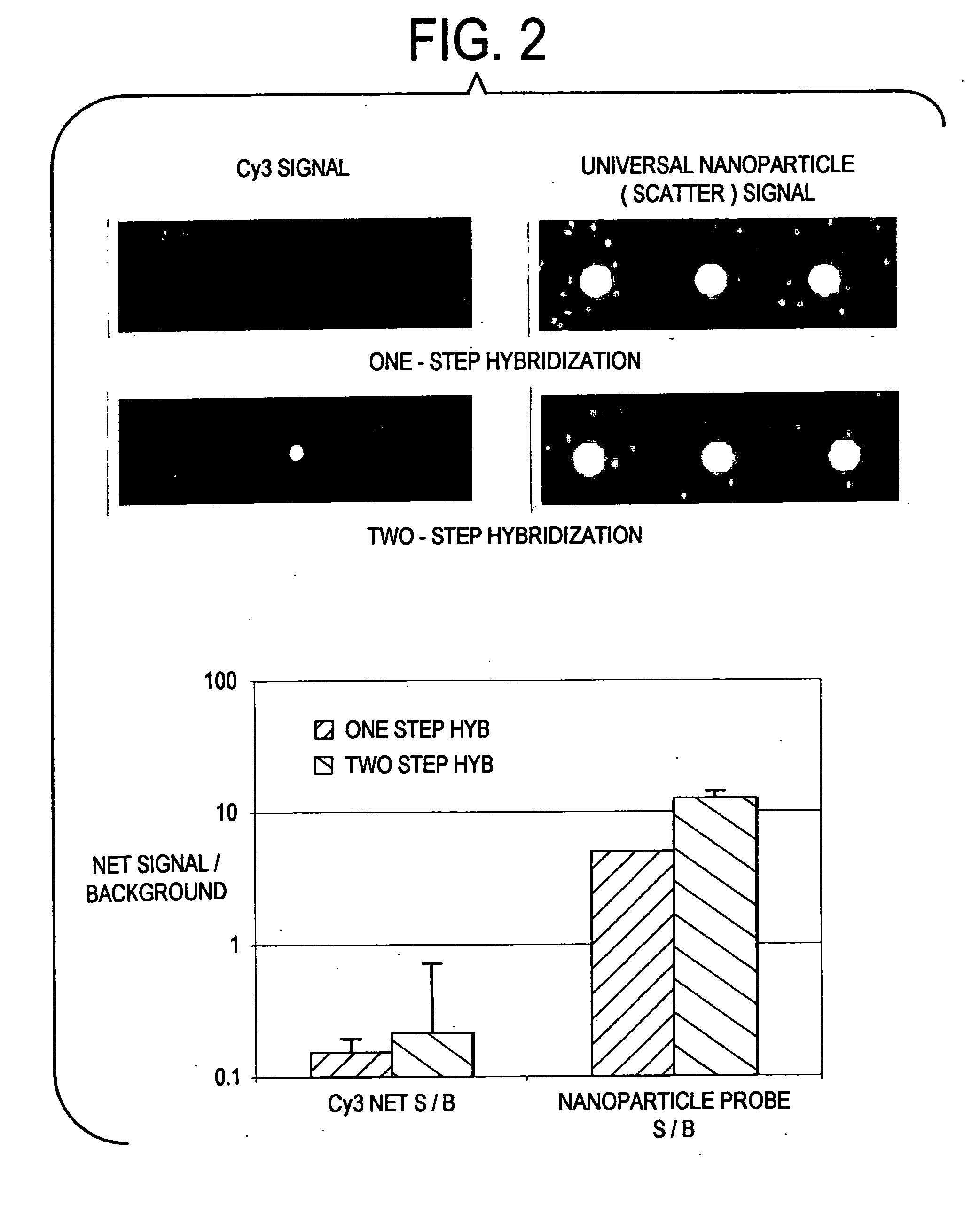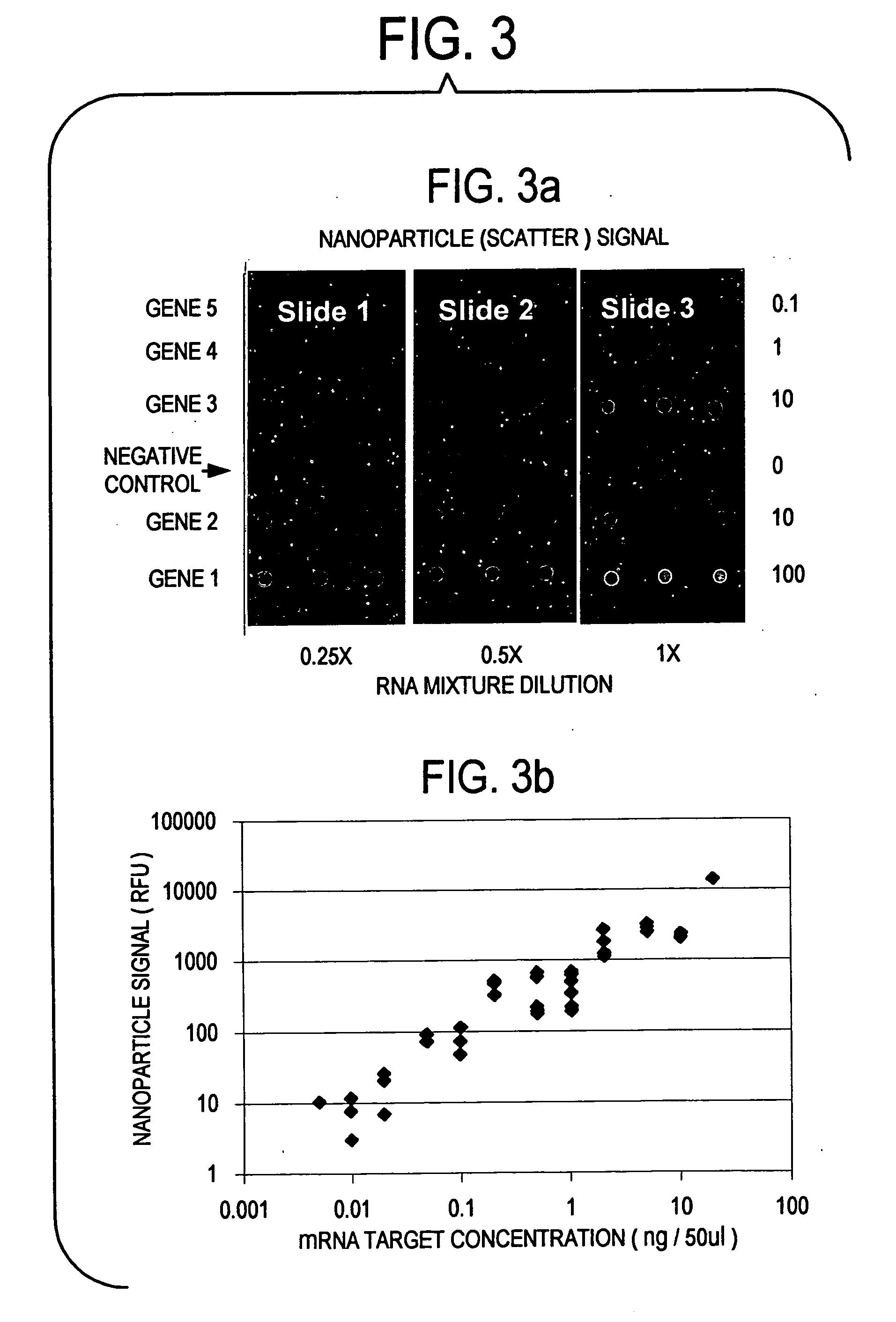Label-free gene expression profiling with universal nanoparticle probes in microarray assay format
a microarray and probe technology, applied in the field of label-free gene expression profiling with universal nanoparticle probes in microarray assay format, can solve the problems of distorting the accuracy of expression analysis, laborious rna labeling and amplification process, cost and time consumption, etc., and achieve high specificity and sensitivity detection
- Summary
- Abstract
- Description
- Claims
- Application Information
AI Technical Summary
Benefits of technology
Problems solved by technology
Method used
Image
Examples
example 1
Single-Step and Two-Step Hybridization Methods for Label-Free Gene Expression Detection Using Nanoparticle Probes
[0088] Nanoparticle-oligonucleotide probes to detect target RNA sequences were prepared using procedures described in PCT / US97 / 12783, filed Jul. 21, 1997; PCT / US00 / 17507, filed Jun. 26, 2000; PCT / US01 / 01190, filed Jan. 12, 2001, which are incorporated by reference in their entirety. Universal gold nanoparticle probes having oligonucleotides bound thereto were used for detection of various target RNA targets using a DNA microarray having anti-sense capture probe oligonucleotides. Nanoparticles (e.g., 15 nm gold particles) are functionalized with poly dT (6mer to 100mer) or poly dA (6mer to 100mer) oligonucleotides, or a unique oligonucleotides (6mer-100mer) via a di-sulfide bond. The poly dT- or poly dA- or unique oligonucleotides-modified gold particles serve as the universal probes for label-free expression analysis discussed in Example 2. The sequence of the oligonucl...
example 2
Label-Free Human Gene Expression Analysis Using Universal Nanoparticle Probes
[0164] A human test array was designed to examine the feasibility of applying universal nanoparticle probes for label-free human gene expression analysis using the procedures and materials described in Example 1. Fourteen human gene specific oligonucleotides (amino-modified 70mer) were purchased from Midland, Tex. and printed at 100 μM on CodeLink glass slides. 15 nm gold particles were functionalized with poly dT (20mer). However, the probe-capture binding was observed with some of the capture oligonucleotides (e.g., human beta actin). The hybridization conditions are as follows: Two capture oligos (beta actin and XX) were spotted on CodeLink slides. The oligo-dT 20mer gold particle probe (1 nM) was added on to microarray in a mixture containing 20%-40% formamide, 4×SSC, and 0.04% TWEEN 20, at 40° C. for 30 min. After hybridization, the arrays were washed in 0.5M NaNO3 and 0.05% TWEEN 20 at room temperat...
PUM
 Login to View More
Login to View More Abstract
Description
Claims
Application Information
 Login to View More
Login to View More - R&D
- Intellectual Property
- Life Sciences
- Materials
- Tech Scout
- Unparalleled Data Quality
- Higher Quality Content
- 60% Fewer Hallucinations
Browse by: Latest US Patents, China's latest patents, Technical Efficacy Thesaurus, Application Domain, Technology Topic, Popular Technical Reports.
© 2025 PatSnap. All rights reserved.Legal|Privacy policy|Modern Slavery Act Transparency Statement|Sitemap|About US| Contact US: help@patsnap.com



